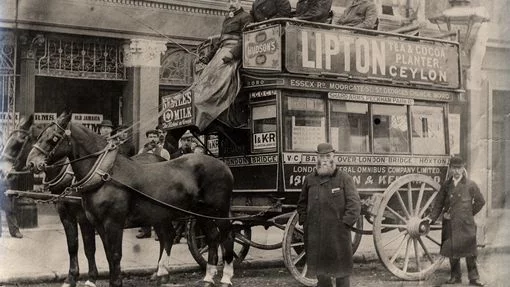
London buses during the First World War
Introduction
When the First World War broke out, the era of the horse bus drew to a close. London’s largest bus operator, the London General Omnibus Company (LGOC), had replaced all its horse buses with motor buses in 1911 and 1912. A few other bus operators continued to use horses until August 1914.
These new vehicles, especially the B type bus, manufactured first by the LGOC and later by the Associated Equipment Company (AEC), were of interest to the War Department because of their reliability. They were built of interchangeable parts, which made roadside repairs much easier. In the first few months of the war, the War Department requisitioned approximately 1,000 London buses, over a third of the LGOC’s fleet.
Some of these vehicles were used for war service in Britain. Others were shipped from large commercial ports, such as Avonmouth, and travelled mainly to France and Belgium, although some went as far as Greece.

The versatility of these motor buses meant they were put to a variety of uses. Many were converted into lorries, with others serving as ambulances, mobile workshops or even mobile pigeon lofts.

However, their most familiar use was as troop carriers, transporting troops between the camps and the front lines. The troop carriers had their windows replaced with wooden planks for safety. Each bus could carry 25 soldiers, which was fewer than the 34 passengers they carried in London. Numbers were halved on the top deck to prevent the bus becoming too top heavy on uneven roads.
Driving and vehicle maintenance were specialist skills in 1914, and many London bus drivers and mechanics were recruited with their vehicles. Bus driving was a ‘reserved occupation’, which meant that bus drivers could not be conscripted into the armed forces. Those who enlisted were volunteers. At the front, drivers worked in teams of two with one resting while the other was driving. They were on call 24 hours a day and slept on their vehicles in cramped, uncomfortable conditions. Many were injured or killed in service.
Back on the home front, London suffered from a shortage of buses and staff. While men were away fighting the war, women were recruited into various transport roles to keep London moving. For the first time, women worked as station staff, bus and train cleaners, bus mechanics and conductors.
In 1919, with the return of peace, women lost their wartime jobs to men who came back from the war. Some of the requisitioned buses also returned to London’s streets, but many were lost or too badly damaged by the harsh conditions at the front, including heavy use, bad roads, frost and shell fire. A new bus, the K type, had been in development when the war broke out, and it was introduced in 1919. Rebuilding took time, however, and bus services recovered slowly, with many passengers relying on uncomfortable Traffic Emergency Buses, an austere solution to the vehicle shortage. B type buses remained in service until 1927.

Of over 2,500 B type buses built, only four remain today. Two of these are part of London Transport Museum’s collection: B340, built in 1911 (object number 1981/514), and B2737, built in 1913 (object number 2013/10256).
Bus number B2737 was restored into operational condition and converted into a military troop carrier in 2014, to commemorate the centenary of the First World War and the role of London’s buses and bus staff in it. It has been taken on two commemorative tours to locations where London buses served on the Somme and in Flanders.
Many of the stories and objects here can be seen within the London’s transport at war gallery at the Museum.

















